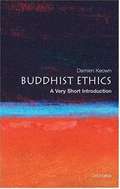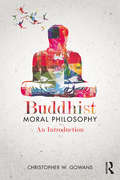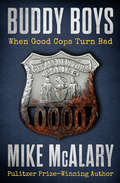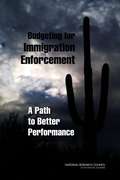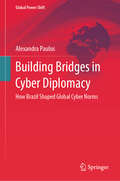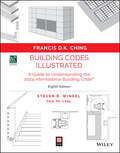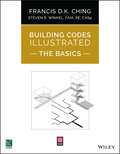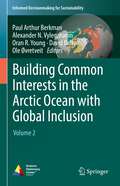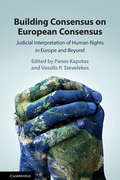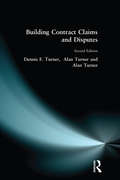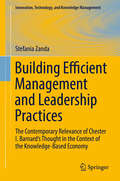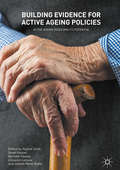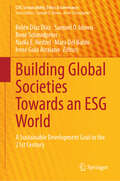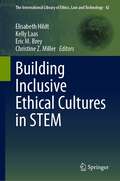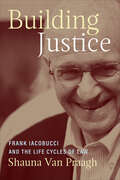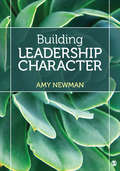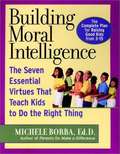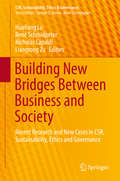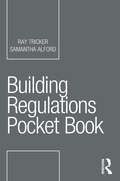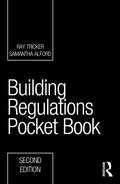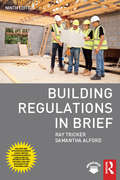- Table View
- List View
Buddhist Ethics: A Philosophical Exploration (Buddhist Philosophy for Philosophers Series)
by Jay L. GarfieldBuddhist Ethics presents an outline of Buddhist ethical thought. It is not a defense of Buddhist approaches to ethics as opposed to any other, nor is it a critique of the Western tradition. <p><p>Garfield presents a broad overview of a range of Buddhist approaches to the question of moral philosophy. He draws on a variety of thinkers, reflecting the great diversity of this 2500-year-old tradition in philosophy but also the principles that tie them together. In particular, he engages with the literature that argues that Buddhist ethics is best understood as a species of virtue ethics, and with those who argue that it is best understood as consequentialist. Garfield argues that while there are important points of contact with these Western frameworks, Buddhist ethics is distinctive, and is a kind of moral phenomenology that is concerned with the ways in which we experience ourselves as agents and others as moral fellows.
Buddhist Ethics: A Very Short Introduction
by Damien KeownThe latter half of the twentieth century witnessed a growing interest in Buddhism, and it continues to capture the imagination of many in the West who see it as either an alternative or a supplement to their own religious beliefs. Numerous introductory books have appeared in recent years to cater for this growing interest, but almost none devotes attention to the specifically ethical dimension of the tradition. For complex cultural and historical reasons, ethics has not received as much attention in traditional Buddhist thought as it has in the West, and publications on the subject are few and far between. Here, Damien Keown, author of Buddhism: A Very Short Introduction , illustrates how Buddhism might approach a range of fascinating moral issues ranging from abortion and suicide to cloning.
Buddhist Moral Philosophy: An Introduction
by Christopher W. GowansThe first book of its kind, Buddhist Moral Philosophy: An Introduction introduces the reader to contemporary philosophical interpretations and analyses of Buddhist ethics. It begins with a survey of traditional Buddhist ethical thought and practice, mainly in the Pali Canon and early Mah?y?na schools, and an account of the emergence of Buddhist moral philosophy as a distinct discipline in the modern world. It then examines recent debates about karma, rebirth and nirvana, well-being, normative ethics, moral objectivity, moral psychology, and the issue of freedom, responsibility and determinism. The book also introduces the reader to philosophical discussions of topics in socially engaged Buddhism such as human rights, war and peace, and environmental ethics.
Buddy Boys: When Good Cops Turn Bad
by Mike McalaryA shocking true story of corruption and crime in the ranks of the NYPD in the worst police scandal since the revelations of Fred Serpico In the 1970s, New York City's 77th Precinct was known as "the Alamo." In Bedford-Stuyvesant and Crown Heights, Brooklyn--neighborhoods notorious for drugs and violent crime--some of the worst criminals wore police uniforms and carried badges. Henry Winter was a good cop when he first entered the infamous 77th station house that was already infamous as a home to the dregs of the NYPD. Before long, he and fellow officer Anthony Magno found themselves deeply entrenched in the Alamo's culture of extortion, lies, corruption, and crime--and they were regularly supplementing their incomes by ripping off thieves, drug dealers, junkies, and honest citizens alike. But the gravy train couldn't stay on the rails forever. Winter and Magno were caught and faced a devastating choice: They could betray their crooked friends and colleagues by helping investigators expose the rot that festered at the Alamo's core--or spend the next several years behind bars. In Buddy Boys, Pulitzer Prize-winning investigative journalist Mike McAlary blows the doors off 1 of the worst scandals ever to taint New York's uniformed guardians, the men and women sworn to protect and serve the populace. Blistering, shocking, and powerful, it's a frightening look inside the NYPD and an eye-opening exploration of the daily temptations that can seduce a good cop over to the dark side.
Budget Speech 2017-18
by Arun JaitleyArun Jaitley Minister of Finance present the Budget for 2017-18.
Budgeting for Immigration Enforcement
by National Research Council Peter Reuter Division of Behavioral and Social Sciences and Education Malay Majmundar Committee on Law and Justice Steve Redburn Committee on Estimating Costs of Immigration Enforcement in the Department of JusticeImmigration enforcement is carried out by a complex legal and administrative system, operating under frequently changing legislative mandates and policy guidance, with authority and funding spread across several agencies in two executive departments and the courts. The U.S. Department of Homeland Security (DHS) is responsible for conducting immigration enforcement both at the border and in the United States; the U.S. Department of Justice (DOJ) is responsible for conducting immigration removal procedures and criminal trials and for prosecuting people charged with immigration-related crimes. DOJ confronts at least five technical challenges to modeling its resource needs for immigration enforcement that are specific to the immigration enforcement system. Despite the inherent limitations, budgeting for immigration enforcement can be improved by changing the method for budgeting. Budgeting for Immigration Enforcement addresses how to improve budgeting for the federal immigration enforcement system, specifically focusing on the parts of that system that are operated and funded by the U.S. Department of Justice (DOJ). The report recommends that DOJ establish policy-level procedures to plan and coordinate policy planning and implementation to improve performance of the immigration enforcement system. The report also recommends that DOJ and DHS accelerate their design of an integrated capacity to track cases and project immigration enforcement activity. Policy makers and others who are interested in how the nation's immigration enforcement system is organized and operates also will find it useful.
Building Bridges in Cyber Diplomacy: How Brazil Shaped Global Cyber Norms (Global Power Shift)
by Alexandra PaulusThis book examines the international forums in which states develop cyber norms—“rules of the road” for how governments use information and communication technologies. To understand the dynamics in this emerging field of diplomacy, the book focuses on an often-overlooked actor: Brazil. With the international debate dominated by two camps that can be broadly characterized as the West versus China and Russia, the book demonstrates that Brazil holds a key position as a bridge-builder between these two sides. It paints a rich picture of Brazil’s efforts in shaping cyber norms across such diverse forums as the United Nations, BRICS, and the Organization of American States, while contextualizing these activities in Brazilian domestic cybersecurity policy and foreign policy traditions. This rich case study paves the way for a deeper understanding of how different actors shape international cybersecurity policy.
Building Codes Illustrated: A Guide to Understanding the 2021 International Building Code (Building Codes Illustrated)
by Francis D. Ching Steven R. WinkelBUILDING CODES ILLUSTRATED STAY INFORMED OF THE LATEST UPDATES TO THE INTERNATIONAL BUILDING CODE WITH THE LEADING VISUAL REFERENCE In the newly revised Seventh Edition of Building Codes Illustrated: A Guide to Understanding the 2021 International Building Code®, architectural drawing expert Francis D.K. Ching and well known architect Steven R. Winkel deliver a beautifully illustrated and intuitively written handbook for the 2021 International Building Code (IBC). The authors provide brand new chapters on plumbing fixture counts, elevators, special construction, and existing buildings while updating the remainder of the material to align with recent changes to the IBC. Easy to navigate and perfect as a quick-reference guide to the IBC, Building Codes Illustrated is a valuable visual resource for emerging professionals. The book also includes: Thorough introductions to navigating the Code, use and occupancy, special uses and occupancies, and building heights and areas Full explorations of the types of construction, fire resistive construction, interior finishes, fire-protection systems, and means of egress Practical discussions of accessibility, interior environment, exterior walls, roof assemblies, and structural provisions In-depth examinations of special inspections and tests, soils and foundations, building materials and systems, and elevators Perfect for students of architecture, interior design, construction, and engineering, the latest edition of Building Codes Illustrated is also ideal for professionals in these fields seeking an up-to-date reference on the 2021 International Building Code.
Building Codes Illustrated: A Guide to Understanding the 2024 International Building Code (Building Codes Illustrated)
by Francis D. Ching Steven R. WinkelSTAY INFORMED OF THE LATEST UPDATES TO THE INTERNATIONAL BUILDING CODE WITH THE LEADING VISUAL REFERENCE In the newly revised Eighth Edition of Building Codes Illustrated: A Guide to Understanding the 2024 International Building Code®, architectural drawing expert Francis D.K. Ching and well-known architect Steven R. Winkel deliver a beautifully illustrated and intuitively written handbook for the 2024 International Building Code (IBC). The authors provide updated material in all the chapters to align with the code changes in the new 2024 International Building Code (IBC). Easy to navigate and perfect as a quick-reference guide to the IBC, Building Codes Illustrated is a valuable visual resource for emerging professionals. The book also includes: Thorough introductions to navigating the Code, use and occupancy, special uses and occupancies, and building heights and areasFull explorations of the types of construction, fire resistive construction, interior finishes, fire-protection systems, and means of egressPractical discussions of accessibility, interior environment, exterior walls, roof assemblies, and structural provisionsIn-depth examinations of special inspections and tests, soils and foundations, building materials and systems, and elevators Perfect for students of architecture, interior design, construction, and engineering, the latest edition of Building Codes Illustrated is also ideal for professionals in these fields seeking an up-to-date reference on the 2024 International Building Code.
Building Codes Illustrated: The Basics (Building Codes Illustrated)
by Francis D. Ching Steven R. WinkelA visual introduction to the fundamentals of the 2021 International Building Code In Building Codes Illustrated: The Basics, architectural illustration expert Francis D.K. Ching and California architect and engineer Steven R. Winkel deliver a concise visual introduction to the 2021 International Building Code (IBC) distilled from the industry bestseller Building Codes Illustrated. With clear language and Frank Ching's distinctive illustrations, the book offers readers a sound understanding of the foundations of the IBC. The authors cover only the most relevant topics, and have designed this book to serve as a companion textbook for students taking introductory courses. Building Codes Illustrated: The Basics is also an essential study resource for the Codes and Regulations section of the Architect Registration Exam developed by NCARB. This book also provides: A solid understanding of the fundamentals of the 2021 International Building Code for students without a background in architecture or engineering Intuitive and memorable study material for people seeking licensure via the Architect Registration Exam Visually striking and memorable material designed to catch the reader's eye, hold attention, and improve retention Perfect for undergraduate students in 2- to 4-year courses studying building codes and specifications, Building Codes Illustrated: The Basics is also ideal for early-career professionals in architecture, interior design, construction management, and engineering.
Building Common Interests in the Arctic Ocean with Global Inclusion: Volume 2 (Informed Decisionmaking for Sustainability)
by Oran R. Young Paul Arthur Berkman Alexander N. Vylegzhanin David A. Balton Ole Rasmus ØvretveitThis book contains an inclusive compilation of perspectives about the Arctic Ocean with contributions that extend from Indigenous residents and early career scientists to Foreign Ministers, involving perspectives across the spectrum of subnational-national-international jurisdictions. The Arctic Ocean is being transformed with global climate warming into a seasonally ice-free sea, creating challenges as well as opportunities that operate short-to-long term, underscoring the necessity to make informed decisions across a continuum of urgencies from security to sustainability time scales. The Arctic Ocean offers a case study with lessons that are especially profound at this moment when humankind is exposed to a pandemic, awakening a common interest in survival across our globally-interconnected civilization unlike any period since the Second World War. This second volume in the Informed Decisionmaking for Sustainability series reveals that building global inclusion involves common interests to address changes effectively “for the benefit of all on Earth across generations.”
Building Consensus on European Consensus: Judicial Interpretation of Human Rights in Europe and Beyond
by Panos Kapotas Vassilis P. TzevelekosShould prisoners have voting rights? Should terminally ill patients have a right to assisted suicide? Should same-sex couples have a right to marry and adopt? The book examines how such questions can be resolved within the framework of the European Convention of Human Rights. 'European consensus' is a tool of interpretation used by the European Court of Human Rights as a means to identify evolution in the laws and practices of national legal systems when addressing morally sensitive or politically controversial human rights questions. If European consensus exists, the Court can establish new human rights standards that will be binding across European states. The chapters of the book are structured around three themes: a) conceptualisation of European consensus, its modus operandi and its effects; b) critical evaluation of its legitimacy and of its outputs; c) comparison with similar methods of judicial interpretation in other legal systems.
Building Contract Claims and Disputes (Chartered Institute Of Building Professional Ser.)
by Dennis F. Turner Alan TurnerThe second edition of Building Contract Claims and Disputes (first published as Building Contract Disputes) provides a study of the causes of contractual disputes, particularly of claims in construction projects and of how they can be resolved successfully. It examines contracts, decisions, documentation and project operation from the points of view of clients, contractors, subcontractors and professional advisers. Readers in practice will find this book an invaluable and comprehensive reference. Those taking professional examinations or degree and postgraduate courses will also benefit greatly from it.The book explains the background, preparation and settlement of claims, with negotiation and dispute resolution from mediation to adjudication, arbitration and legal proceedings. The interrelations of variations, extension of time and loss and expense are considered. Three specially structured case studies of construction projects illustrate and apply the principles to detailed practical situations. This edition deals with a considerably expanded range of contracts, including JCT, GC/Works/1, design and build, minor works, ICE and innovative NEC. It covers recent legal rulings and changes in the law and contract forms, as well as parts of the Housing Grants, Construction and Regeneration Act 1996 and the Arbitration Act 1996.
Building Efficient Management and Leadership Practices: The Contemporary Relevance of Chester I. Barnard's Thought in the Context of the Knowledge-Based Economy (Innovation, Technology, and Knowledge Management)
by Stefania ZandaThis book examines the relationships among leadership, the quality of the management process and business results. Drawing from the pioneering contributions of Chester I. Barnard, this book defines the role and characteristics of an effective and efficient manager in the new knowledge economy. This book also examines the relevance of Barnard's work on modern studies in economics and business administration. Chester I. Barnard considered the company to be a complex socio-economic system, oriented towards general aims. A company's behavior is rational if its constituent elements and management models are planned, organized, guided and regulated in order to create and maintain a cooperative system that combines efficiency and effectiveness. In this book, the conceptual construction of Barnard's management theory is represented by a synthetic scheme in which the various components of the business process (including leadership) and their influences on the outcome variables of the company are linked as a system. This approach makes this book appealing to academics, scholars and professionals in business, management, administration and knowledge management.
Building Evidence for Active Ageing Policies: Active Ageing Index and its Potential
by Sarah Harper Asghar Zaidi Kenneth Howse Giovanni Lamura Jolanta Perek-BiałasThis book provides multinational evidence on active and healthy ageing. It generates authoritative new knowledge for mutual learning and policymaking in addressing challenges linked with population ageing. The authors discuss how to achieve better active ageing outcomes through appropriate policies including addressing life course determinants of active and healthy ageing. The chapters are distinctive in their focus on quantitative analysis of active and healthy ageing based on a first-of-its-kind composite measure, the Active Ageing Index developed during the 2012 European Year for Active Ageing and Solidarity between Generations. Contributors include researchers, civil service representatives, policymakers and other stakeholders from national, regional and European organisations. This edited volume provides a multidisciplinary resource for academics and policy makers in various areas of the social sciences, especially those studying population ageing and its consequences, economists, sociologists, social policy analysts and public health experts.
Building Global Societies Towards an ESG World: A Sustainable Development Goal in the 21st Century (CSR, Sustainability, Ethics & Governance)
by Samuel O. Idowu René Schmidpeter Mara Del Baldo Belén Díaz Díaz Nadia E. Nedzel Irene Guia ArraianoThis book provides insightful approaches to how to improve business sustainability. The volume includes an integrated analysis of different relevant aspects of Environmental, Social, and Governance (ESG) and provides an international view of Corporate Social Responsibility (CSR). The book explores these topics with the aim to share ideas and visions for a sustainable future and to provide useful tips for academics, practitioners, and policy-makers in the context of the 2030 Agenda for Sustainable Development of the United Nations.
Building Inclusive Ethical Cultures in STEM (The International Library of Ethics, Law and Technology #42)
by Elisabeth Hildt Eric M. Brey Kelly Laas Christine Z. MillerThis book shares innovative approaches to effectively engage students and faculty working in research labs, lab-based classrooms and courses to build inclusive ethical cultures. The frameworks and approaches presented move beyond traditional research ethics training to strengthen the ethical culture in research labs. The chapters in the book showcase best practices and approaches to embedding educational interventions in courses, research labs and departments. The book is based on the two-day workshop “Building Inclusive Ethical Cultures in STEM” (April 23-24, 2021). Moving beyond the two-day conference that inspired this collected volume, the various chapters address questions like: What are approaches and tools to integrate ethics education in STEM effectively? How can STEM ethics education be improved? What can researchers do to build more inclusive research environments? How can meaningful discussions about ethics be effectively integrated into STEM courses, research labs, and workplace environments? While each chapter takes a different perspective and is located in its respective context, the contributions are united by the goal of effectively including ethical reflection in STEM education. Instructors from both four-year and two-year colleges who teach STEM and lab-based STEM courses; young principal investigators/junior faculty who are in the process of building their research groups; departmental chairs interested in programmatic approaches for improving mentoring, research ethics education, and the research culture of their department, will find this work to be a very valuable resource in their daily practice.
Building Justice: Frank Iacobucci and the Life Cycles of Law
by Shauna Van PraaghBuilding Justice draws on the inspiring life of former Canadian Supreme Court Justice Frank Iacobucci to offer insight into the meaning of engaged citizenship through law. Ignoring early advice that he had the wrong kind of name to go to law school, Frank Iacobucci, the son of Italian immigrants, made a name for himself as an outstanding Canadian jurist. Serving as justice of the Supreme Court of Canada from 1991 to 2004, Iacobucci was also professor and dean of law at the University of Toronto and deputy minister of justice for Canada. In Building Justice, Shauna Van Praagh weaves together the voices of individuals whose paths and projects have intersected with those of Frank Iacobucci. The book provides a compelling consideration of the study and practice of law as it follows the stages of Iacobucci’s life and career: from his childhood in Vancouver, his practice as a young lawyer, his time at the University of Toronto and with the Federal Department of Justice, his work as a judge at the highest level of court, and his significant engagement with Canada’s ongoing response to the legacy of residential schools. Building Justice is a beautifully written biography in which the stories of one jurist serve to explore and illustrate engaged citizenship through law.
Building Leadership Character: Lessons In Authenticity And Credibility
by Amy NewmanExtending beyond traditional leadership books to offer readers a path for developing their own character, this compelling new text uses a storytelling approach and real-world cases to explore different dimensions of leadership character. With a clear, student-friendly writing style, bestselling author Amy Newman deftly captures various approaches in which corporations and people respond to situations in difficult times and learn from mistakes. Using real companies and situations, each chapter examines a leadership character dimension such as accountability, integrity, authenticity, and courage. Readers will learn to develop their own character, emotional intelligence, and leadership skills as they engage with assessments, reflection opportunities, and exercises.
Building Leadership Character: Lessons In Authenticity And Credibility
by Amy NewmanExtending beyond traditional leadership books to offer readers a path for developing their own character, this compelling new text uses a storytelling approach and real-world cases to explore different dimensions of leadership character. With a clear, student-friendly writing style, bestselling author Amy Newman deftly captures various approaches in which corporations and people respond to situations in difficult times and learn from mistakes. Using real companies and situations, each chapter examines a leadership character dimension such as accountability, integrity, authenticity, and courage. Readers will learn to develop their own character, emotional intelligence, and leadership skills as they engage with assessments, reflection opportunities, and exercises.
Building Moral Intelligence
by Michele BorbaGain a new understanding of moral intelligence, and a step-by-step program for its achievement from bestselling author, Michele Borba. In this indispensable book for parents, Borba has created a new break-through in conceptualizing and teaching virtue, character and values under the auspices of a measurable capacity -- Moral Intelligence. This book confronts the front-page crisis we now face in our country regarding youth violence, alienation, self-destructive behavior, cold-heartedness, lack of compassion, insensitivity, intolerance and the break down of values. The author provides a new way to understand, evaluate and inspire our kids with the seven essential virtues which comprise moral intelligence.
Building New Bridges Between Business and Society: Recent Research and New Cases in CSR, Sustainability, Ethics and Governance (CSR, Sustainability, Ethics & Governance)
by Nicholas Capaldi René Schmidpeter Hualiang Lu Liangrong ZuThis book provides a comprehensive understanding of the linkages between business and society by addressing key issues in corporate social responsibility (CSR), sustainability, ethics and governance. Thanks to the different visions and perspectives offered by a global group of authors with a broad range of expertise, the book offers a full spectrum of theoretical and practical approaches. Further, it combines the latest theoretical thinking with reviews of frameworks, cases and best practices from various industries and nations. In particular, the book offers a historical perspective on the origins of CSR and discusses CSR in relation to sustainability and management, with a special focus on CSR in Asia.
Building Regulations Pocket Book (Routledge Pocket Books)
by Ray Tricker Samantha AlfordThis handy guide provides you with all the information you need to comply with the UK Building Regulations and Approved Documents. On site, in the van, in the office, wherever you are, this is the book you’ll refer to time and time again to double check the regulations on your current job. The Building Regulations Pocket Book is the must have reliable and portable guide to compliance with the Building Regulations. Part 1 provides an overview of the Building Act Part 2 offers a handy guide to the dos and don’ts of gaining the Local Council’s approval for Planning Permission and Building Regulations Approval Part 3 presents an overview of the requirements of the Approved Documents associated with the Building Regulations Part 4 is an easy to read explanation of the essential requirements of the Building Regulations that any architect, builder or DIYer needs to know to keep their work safe and compliant on both domestic or non-domestic jobs This book is essential reading for all building contractors and sub-contractors, site engineers, building engineers, building control officers, building surveyors, architects, construction site managers and DIYers. Homeowners will also find it useful to understand what they are responsible for when they have work done on their home (ignorance of the regulations is no defence when it comes to compliance!).
Building Regulations Pocket Book (Routledge Pocket Books)
by Ray Tricker Samantha AlfordThe new edition of the Building Regulations Pocket Book has been fully updated with recent changes to the UK Building Regulations and Planning Law. This handy guide provides you with all the information you need to comply with the UK Building Regulations and Approved Documents. On site, in the van, in the office – wherever you are – this is the book you’ll refer to time and time again to check the regulations on your current job. Part 1 provides an overview of the Building Act. Part 2 offers a handy guide to the dos and don’ts of gaining the Local Council’s approval for Planning Permission and Building Regulations Approval. Part 3 presents an overview of the requirements of the Approved Documents associated with the Building Regulations. Part 4 is an easy-to-read explanation of the essential requirements of the Building Regulations that any architect, builder or DIYer needs to know to keep their work safe and compliant on both domestic and non-domestic jobs. Key new updates to this second edition include, but are not limited to: changes to the fire regulations as a result of the Hackitt Review, updates to Approved Document F and L, new Approved Documents covering Overheating (AD-O) and Infrastructure for the charging of electric vehicles (AD-S), amendments to and the reinstatement of the Manual to the Building Regulations. This book is essential reading for all building contractors and sub-contractors, site engineers, building engineers, building control officers, building surveyors, architects, construction site managers as well as DIYers and those who are supervising work in their own home.
Building Regulations in Brief
by Ray Tricker Samantha AlfordThis ninth edition of the most popular and trusted guide reflects all the latest amendments to the Building Regulations, planning permission and the Approved Documents in England and Wales. This includes coverage of the new Approved Document Q on security, and a second part to Approved Document M which divides the regulations for 'dwellings' and 'buildings other than dwellings'. A new chapter has been added to incorporate these changes and to make the book more user friendly. Giving practical information throughout on how to work with (and within) the Regulations, this book enables compliance in the simplest and most cost-effective manner possible. The no-nonsense approach of Building Regulations in Brief cuts through any confusion and explains the meaning of the Regulations. Consequently, it has become a favourite for anyone in the building industry or studying, as well as those planning to have work carried out on their home.

